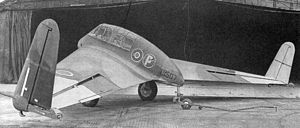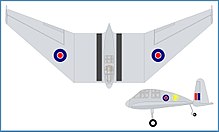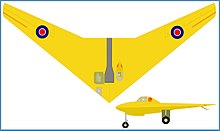General Aircraft GAL. 56
| General Aircraft GAL. 56 | |
|---|---|
 General Aircraft GAL.56 / 01 TS507 |
|
| Type: | Experimental airplane |
| Design country: | |
| Manufacturer: | |
| First flight: |
November 1944 |
| Number of pieces: |
3 |
Under the common name General Aircraft GAL.56 , the British manufacturer General Aircraft Limited (GAL) built three experimental, tailless swept wing gliders in the 1940s .
history
Experimental concept
In July 1943, the Advisory Committee for Flying Wing Aircraft was established under the Directorate for Scientific Research, which was assigned to the Ministry of Supply . The purpose was to find suitable design concepts for tailless aircraft.
General Aircraft's participation in the program was certainly due to the previous developments in heavy cargo gliders. The Air Ministry commissioned GAL with the construction of two glider fuselages, each of which was to accommodate a pilot and an observer. In addition, the production of six interchangeable wings with different floor plans was commissioned. The fuselages were to be instrumented in such a way that all information generated during the descent of the aircraft after it was separated from a tow plane could be recorded. The six wings included three with a V-shape (V-version) and three with a straight center piece and swept outer wings (U-version). In fact, only two of the first and one of the second type were flown, and complete aircraft were built for each wing. All three aircraft were given the designation GAL.56 (also GAL 56). The design team at GAL was also jokingly called the Foreign Legion , as exiles from Austria, Czechoslovakia and Poland worked together under the direction of Otto Wels, the former chief engineer of Aero in Prague.
Other types involved in this trial were the Armstrong Whitworth Aircraft AW.52G and AW.52 , the De Havilland DH.108 Swallow, and the Handley Page HP.75 Manx .
Test aircraft
The three aircraft built by GAL were:
- GAL.56/01
(RAF serial number TS507 ) Also known as the "Medium-V" version, had a constant 33.5 ° wing sweep on the leading edge and 28.4 ° on the trailing edge. On November 13, 1944, Robert Kronfeld conducted the first test flight at Farnborough, towed by an Armstrong Whitworth Whitley . The machine was exhibited at the SBAC display in Radlett in September 1947.
- GAL. 56/04
( TS510D ) Also known as the "Medium-U" version, it had a swept-back center wing and a swept wing shape similar to that of the GAL.56 / 01 on the outer wing. Total span 51 ft (15.5 m). The first flight was on February 27, 1946 on the RAF Aldermaston .
- GAL.56/03
( TS513B ) Also known as the "Maximum-V" version, it had a constant 40 ° wing sweep on the leading edge and 36.4 ° on the wing trailing edge. The wingspan was the same as with the GAL.56/01. The first flight took place on May 30, 1946. This machine was also exhibited at the SBAC display in Radlett in September 1947. Here she wore noticeable extensions in the outer area of the wing leading edge.
testing
The GAL.56 / 01 was flown in by GAL at RAF Dunholme Lodge in 1945 and then handed over to the Royal Aircraft Establishment in Farnborough, where the machine was until August 1947. An Armstrong Whitworth Whitley , Supermarine Spitfire or Handley Page Halifax were used as tow planes .
The actual testing by GAL's test department from April 1947 on at Lasham Airfield in Hampshire , where GAL had relocated its test department at the end of 1946, could initially only be carried out with the GAL.56 / 03 and / 04. The aim of these Contractor's Flight Trials (CFT) was to have the aircraft accepted by the Air Ministry. The only pilot used for this was Robert Kronfeld . The Handley Page Halifax III (NA295) was used as a towing machine for the gliders. The maximum release height was around 5100 m and the flight duration was only 25 to 40 minutes. The / 03 carried out the first two flights on May 30, 1947. The research program with the / 04 also included the study of movable wing tips to improve controllability at low speeds. The respective angle could only be set firmly on the ground.
On February 12, 1948, the GAL.56 / 01 was towed from a Halifax to 10,000 feet to conduct a stall test. Robert Kronfeld initiates a stable that went into an uncontrollable dive that led to the unconsciousness of the crew. The observer, Barry MacGowan, woke up and found that the aircraft was now in a level flight, but upside down. He was able to get out at a low altitude and save himself with the parachute. But Kronfeld died in the crash at Lower Froyle, near Lasham. After this accident, the entire GAL.56 program was canceled. One result of the test flights was that the selected flying wing configuration did not allow satisfactory control of the aircraft during takeoff and landing.
The other two GAL.56s were transferred to the AFEE (Airborne Forces Experimental Establishment) and the General Aircraft on the RAF Beaulieu. The GAL 61 was never flown.
construction
The three GAL.56 variants used the same fuselage design, but with three different wing designs. The hull of the GAL.56, covered with preformed plywood, had a tubular steel framework structure with molded plywood parts. The pilots and observers were accommodated in a tandem cockpit. In all variants, the structure of the wood-covered wings consisted of plywood spars and wooden ribs. Each wing was connected to the fuselage with a bolt; the bolt could also be used to change the V-position of the wing on the ground. The control was carried out using elevons . Two sets of spreader flaps were installed, each set of which could be preset prior to flight. At the edge of the wing there was a vertical tail fin. The struts of the rigid main landing gear were attached to the wing spars and an extended tail wheel was attached to the end of the fuselage.
Further developments
- GAL.57
A version of the GAL.56 powered by a modified Lycoming R-680 radial engine with 215 hp, designed but not built in 1943.
- GAL.61
( TS515 ) A flying wing without fuselage and vertical stabilizer with retractable nose wheel landing gear . It had a raised cockpit for a pilot and a cockpit for an observer in a prone position in the starboard wing. The GAL.61 had a small engine to power the instruments and recording equipment on board. Instead of the rotating wing tips, this aircraft had so-called trafficators (dt. Automobile beckers ) in the form of extendable “bars” on both wing ends. This element for steering around the yaw axis was based strongly on the Horten H IX . When the Air Ministry discontinued the project, the GAL.61 was about to make its maiden flight.
Technical specifications
| Parameter | Data GAL.56 / 01 |
|---|---|
| crew | 2 (pilot and observer) |
| length | 5.69 m |
| span | 13.82 m |
| height | 3.51 m |
| Wing area | 33 m² |
| Wing extension | 5.8 |
| Wing profile | RAF34 |
| Empty mass | 1544 kg |
| Takeoff mass | 1996 kg |
| Top speed | 322 km / h |
| Minimum speed | 93 km / h |
See also
literature
- Charles Prower: Tailless Experimentals - From Brisfit to Beverley Part Seven. In: Airplane Monthly. November 1993, pp. 44-47.
- Charles Prower: Sweepback Research - From Brisfit to Beverley Part Eight. In: Airplane Monthly. December 1993, pp. 20-23.
- Barry MacGowan: Tailless Tales. In: Airplane Monthly. April 1994, pp. 26-30.
- Ray Sturtivant: British Prototype Aircraft. Haynes, 1995, ISBN 1-85648-221-9 .
Web links
- Century of flight flying wings . Retrieved January 26, 2012.
- Kronfeld Obituary for Kronfeld
Individual evidence
- ↑ a b Sturtivant, 1995, pp. 108-113.
- ^ Prower, December 1993, p. 20.
- ↑ Flight 26 Sep 1946, pp. 327-330.
- ^ Norman Ellison: British Gliders and Sailplanes 1922-1970 . 1st edition. Adam & Charles Black, London 1971, ISBN 0-7136-1189-8 .
- ↑ Prower, December 1993, pp. 20 f.
- ^ Flight September 26, 1946.



